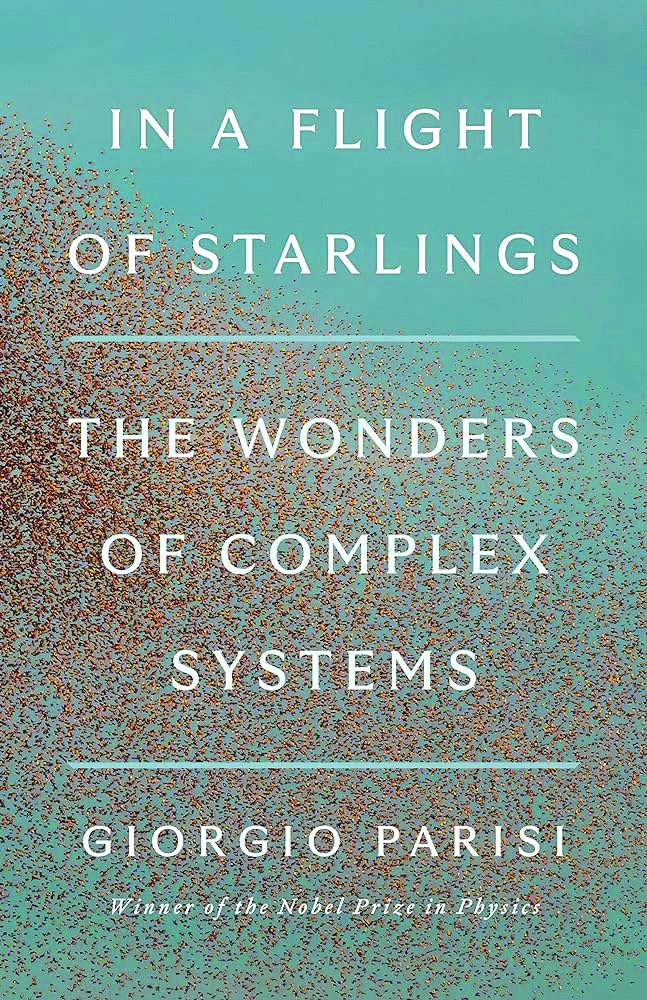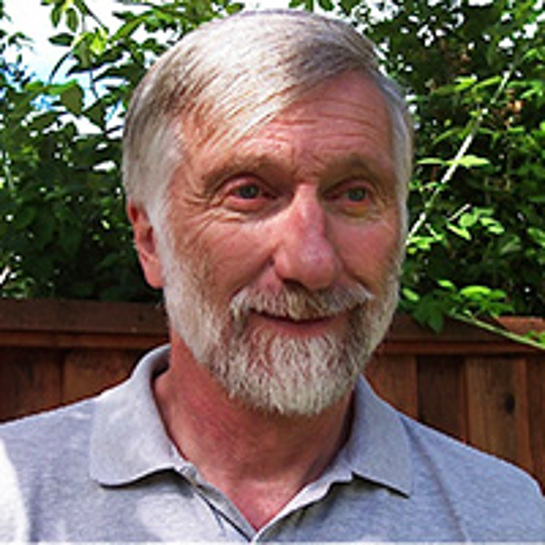Musings on the Statistical Physics of Complex Systems

In a Flight of Starlings: The Wonders of Complex Systems. By Giorgio Parisi. Penguin Press, New York, NY, July 2023. 144 pages, $24.00.
In this slim volume with only eight short chapters, theoretical physicist Giorgio Parisi recounts his life’s work and reflects on the scientific lessons he learned along the way. Parisi—who received the 2021 Nobel Prize in Physics “for the discovery of the interplay of disorder and fluctuations in physical systems from atomic to planetary scales”—writes that “this book is my attempt to convey to a wide readership something of the beauty, importance, and cultural value of modern science.”
Chapter 1 describes Parisi’s study of the flocking behavior of starlings, which he undertook in the mid-2000s. Specifically, he recounts the difficulties of obtaining and analyzing three-dimensional photographs and videos. Parisi concludes this section by noting that local interactions determine the overall dynamics of a flock; in short, how and when a bird turns depends on its relative distance from neighboring birds. This “locality” is of course reminiscent of statistical physics models, so the chapter provides a nice example of statistical physics methods that answer a question about biological population behavior. It is also an exemplar of an effective popular-science-style exposition written by a scientist.
In chapter 2, Parisi describes the state of physics research in Rome around 1970. Here, he comments on the individuals and the work on elementary particles that he witnessed as a junior researcher. Younger readers may be particularly intrigued by some of the practical issues, such as mail communications that were routinely subject to the vagaries of the Italian postal system.
Chapter 3 provides an amiable account of Parisi’s self-perceived missed opportunity for a Nobel Prize in the early 1970s, when he failed to identify the Yang-Mills fields and thus did not create quantum chromodynamics. This sentiment may resonate with some senior readers’ experiences at a less rarified height. The account begins with a verbal description of a problem: Do “bounce” collisions between specific particles occur frequently or infrequently at high energies? Mathematically, the answer to this question depends on knowing whether a certain beta function is positive or negative. This chapter offers a detailed explanation of Parisi’s thoughts, personal explorations, and interactions with other researchers.
Parisi devotes chapter 4 to a dialogue about phase transitions, illustrated by both water (first-order transition) and ferromagnetism (second-order transition). This segment includes sketches of the Ising model and renormalization group methodology; it also addresses the notion that the many different occurrences of phase transitions should fall into only a few universality classes.
In chapter 5, Parisi discusses the parts of his research with which mathematicians are likely most familiar: spin glasses and the replica method. In fact, many people consider these topics to be the achievements that earned him the Nobel Prize. To quote Wikipedia, “Spin glass, when contrasted with a ferromagnet, is defined as [a] ‘disordered’ magnetic state in which spins are aligned randomly or without a regular pattern, and the couplings too are random.” To understand this concept mathematically, consider a model with two metaphoric levels of randomness: deep and surface. One can construct copies with the same realization of the deep randomness but independent realizations of the surface randomness; this construction with \(n\) copies enables the calculation of certain formulas. Parisi’s “Eureka” moment arose when he considered these results as a function of \(n\) and took the continuous limit as \(n\) decreases to zero, which amazingly yielded meaningful answers. This paradoxical formulation and the overtly nonrigorous methodology naturally attracted the attention of theorem proof mathematicians. Subsequent deep work in rigorous theory is evident in the literature [3].
Parisi utilizes chapters 6 and 7 to contemplate the use of metaphors, intuition, and the birth of ideas in science. He illustrates his musings with various stories and remarks that published works in mathematics and the hard sciences “have been completely purified, reduced to formal language in which there is seldom any allusion to non-technical reasoning.” In my own field of mathematical probability, however, this assessment is not true; indeed, the introduction to a research paper should—and often does—provide some intuition as to why readers would expect the main result to be correct. And regarding allusions, I am happy to use an analogy whenever the opportunity arises — such as the comparison between random walks on graphs and electrical networks, for example. In the aforementioned quotation, Parisi is presumably referring to the traditional expectation that scientific papers should contain concise exposition (likely due to the lack of physical journal space). On the contrary, this requirement is surely archaic in the digital era.
Parisi also writes about how the observation “that completely different systems could have the same mathematical description was a very important discovery for physicists.” This statement puzzles me; isn’t the idea that one exponential function arises in many contexts a main practical point of mathematics? As for intuition, I found the content sadly unhelpful because it focused on rather familiar thoughts about the use of intuition in solving a problem. But solving a problem is the easy case; in theoretical mathematics (though perhaps less so in applied mathematics and general science), the ultimate intuition desideratum involves formulating a problem and choosing to work on it based on an intuitive feeling that a solution—or even an attempt at a solution—might open the door to a novel avenue of research.
Finally, chapter 8 briefly examines the relationship between science and society. For instance, Parisi notes that “it is fundamental that scientists find seeking to solve a puzzle fun,” and continues by writing that “science and its institutions need to be funded by society, and society hardly gives a damn about whether the scientists are enjoying their work or not.” He also states that “science needs to be defended not just for its practical aspects but for its cultural value,” but fails to develop this theme throughout the book.
One overall comment about the text is that aside from the initial chapter on starlings, the subject material is not easy to visualize. As such, general readers may be disappointed by not really seeing the advertised “wonders.” The overall tone is likewise a bit too cerebral to entice anyone who is not already interested in physics, and such readers may find the topics and style—which vary between chapters—rather disjointed. As reviewer Sam Kean noted in The American Scholar, “the book ends up stranded between different genres — not quite a beach read, not quite a memoir, not quite a pop-science primer on modern physics” [2].
My own attempts at popular exposition affirm the difficulty of choosing and adhering to a style, so—to put a positive spin on my previous remark—In a Flight of Starlings may serve as a testbed for one’s specific taste in style. In my opinion, chapter 3 successfully provides an entertaining account of progress by different individuals that eventually solves a problem — all while using only superficial descriptions of the actual scientific issues at hand. In contrast, chapter 5 attempts a more informative verbal and pictorial description of replica symmetry (and replica symmetry breaking) that does not effectively convey the message to a reader who is unfamiliar with the physics worldview.
Regarding Parisi’s memoir style, many readers are presumably familiar with G.H. Hardy’s A Mathematician’s Apology, which is replete with delightfully provocative assertions [1]. The opinions and descriptions of cultural backgrounds in Parisi’s tome seem rather bland in comparison.
The SIAM audience might wonder about the connection between theoretical physics and applied mathematics. Many people likely assume that Steven Hawking was part of the Department of Physics at the University of Cambridge, when he was actually a member of the Department of Applied Mathematics and Theoretical Physics within the Faculty of Mathematics. Relativity, quantum theory, and so forth are clearly special to the properties of the physical universe, but I’ve always viewed statistical physics—in the context of biological or human activities—as simply a different kind of applied mathematics. And while the study of quantitative aspects of networks surely ought to be classified as applied math, it has largely been overtaken by statistical physicists and computer scientists.
To conclude on a more uplifting note, it is always worth looking at any exceptional scientist’s account of science topics. Most of Parisi’s chapters have something to say that does not exist elsewhere at this level, and his enthusiasm is clearly evident. Therefore, readers who already have an interest in non-mathematical descriptions of physics are sure to enjoy In a Flight of Starlings. The book will also prove useful for physics or applied mathematics students who wish to view the profession with a sense of breadth that is typically not evident in textbooks or university lectures.
References
[1] Hardy, G.H. (1940). A mathematician’s apology. London, UK: Cambridge University Press.
[2] Kean, S. (2023). Don’t forget intuition. The American Scholar. Retrieved from https://theamericanscholar.org/dont-forget-intuition.
[3] Talagrand, M. (2011). Mean field models for spin glasses: Volume II: Advanced replica-symmetry and low temperature. In A series of modern surveys in mathematics (Vol. 55). Berlin, Germany: Springer-Verlag.
About the Author
David Aldous
Professor, University of California, Berkeley
David Aldous is a professor emeritus at the University of California, Berkeley. His research in mathematical probability explores weak convergence, exchangeability, Markov chain mixing times, continuum random trees, stochastic coalescence, and spatial random networks. He also routinely engages in critical communication about mathematical probability’s connection to the real world.

Stay Up-to-Date with Email Alerts
Sign up for our monthly newsletter and emails about other topics of your choosing.



